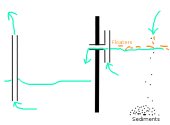




CA, Southern Sierras, alt. 4550 feet, zone 9ish. (still figuring it out), 3 mo. grow season. Regular wind to 20 mph. SANDY soil with scrub oak,pine,and juniper. 2 seasonal creeks.




http://www.greenshireecofarms.com
Zone 5a in Central Ontario, Canada




find religion! church
kiva! hyvä! iloinen! pikkumaatila
get stung! beehives
be hospitable! host-a-hive
be antisocial! facespace




CA, Southern Sierras, alt. 4550 feet, zone 9ish. (still figuring it out), 3 mo. grow season. Regular wind to 20 mph. SANDY soil with scrub oak,pine,and juniper. 2 seasonal creeks.




CA, Southern Sierras, alt. 4550 feet, zone 9ish. (still figuring it out), 3 mo. grow season. Regular wind to 20 mph. SANDY soil with scrub oak,pine,and juniper. 2 seasonal creeks.





Jim Lea wrote:Anything tricky to sand filters? Do you maybe have a good link?Jim
find religion! church
kiva! hyvä! iloinen! pikkumaatila
get stung! beehives
be hospitable! host-a-hive
be antisocial! facespace









CA, Southern Sierras, alt. 4550 feet, zone 9ish. (still figuring it out), 3 mo. grow season. Regular wind to 20 mph. SANDY soil with scrub oak,pine,and juniper. 2 seasonal creeks.





Jim Lea wrote:You guys have some great information. As for rainfall. 11.5 is Avg. This year so far 1. Inches that is.
find religion! church
kiva! hyvä! iloinen! pikkumaatila
get stung! beehives
be hospitable! host-a-hive
be antisocial! facespace












Ampersand Sustainable Learning Center
Find out about our residencies, retreats,classes, events, internships and volunteer opportunities at: www.ampersandproject.org




CA, Southern Sierras, alt. 4550 feet, zone 9ish. (still figuring it out), 3 mo. grow season. Regular wind to 20 mph. SANDY soil with scrub oak,pine,and juniper. 2 seasonal creeks.





find religion! church
kiva! hyvä! iloinen! pikkumaatila
get stung! beehives
be hospitable! host-a-hive
be antisocial! facespace




CA, Southern Sierras, alt. 4550 feet, zone 9ish. (still figuring it out), 3 mo. grow season. Regular wind to 20 mph. SANDY soil with scrub oak,pine,and juniper. 2 seasonal creeks.
 1
1








CA, Southern Sierras, alt. 4550 feet, zone 9ish. (still figuring it out), 3 mo. grow season. Regular wind to 20 mph. SANDY soil with scrub oak,pine,and juniper. 2 seasonal creeks.





|
You ridiculous clown, did you think you could get away with it? This is my favorite tiny ad!
Switching from electric heat to a rocket mass heater reduces your carbon footprint as much as parking 7 cars
http://woodheat.net
|


